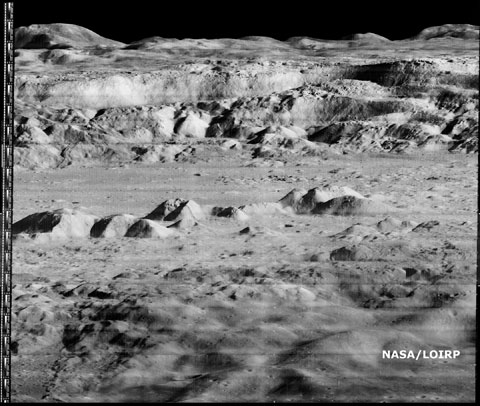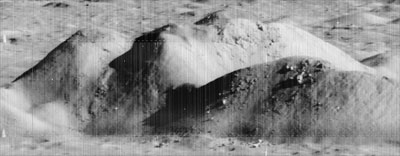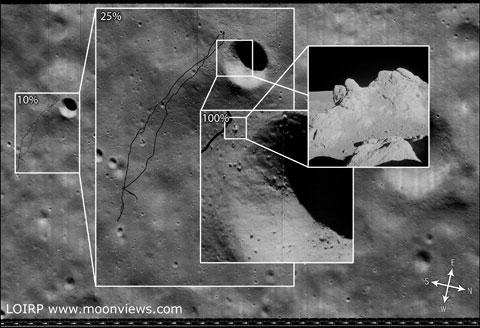|
|

|
|
Author
|
Topic: Lunar Orbiter Image Recovery Project (LOIRP)
|
Robert Pearlman
Editor Posts: 42988
From: Houston, TX
Registered: Nov 1999
|
 posted 11-14-2008 03:54 AM
posted 11-14-2008 03:54 AM
   
NASA release NASA Restores Historic Lunar Orbiter ImageNASA released a newly restored 42-year-old image of Earth on Thursday. The Lunar Orbiter 1 spacecraft took the iconic photograph of Earth rising above the lunar surface in 1966. Using refurbished machinery and modern digital technology, NASA produced the image at a much higher resolution than was possible when it was originally taken. The data may help the next generation of explorers as NASA prepares to return to the moon. In the late 1960s, NASA sent five Lunar Orbiter missions to photograph the surface of the moon and gain a better understanding of the lunar environment in advance of the Apollo program. Data were recorded on large magnetic tapes and transferred to photographic film for scientific analysis. When these images were first retrieved from lunar orbit, only a portion of their true resolution was available because of the limited technology available. The Lunar Orbiter Image Recovery Project, located at NASA's Ames Research Center at Moffett Field, Calif., is taking analog data from original recorders used to store on tape and 1,500 of the original tapes, converting the data into digital form, and reconstructing the images. The restored image released Thursday confirms data from the original tapes can be retrieved from the newly-restored tape drives from the 1960s when combined with software from 2008. "I'm glad that we could offer our services to the project team and play a part in the recovery of such an historic image of the moon," said Ames Director S. Pete Worden. Future images will be made publicly available when they are fully processed and calibrated. The intent of this project is to facilitate, wherever possible, the broadest dissemination and public use of these images. "It's a tremendous feeling to restore a 40-year-old image and know it can be useful to future explorers," said Gregory Schmidt, deputy director of the NASA Lunar Science Institute at Ames. "Now that we've demonstrated the capability to retrieve images, our goal is to complete the tape drives' restoration and move toward retrieving all of the images on the remaining tapes," he added. As the images are processed, they will be submitted to the Planetary Data System, which NASA's Space Science Mission Directorate in Washington sponsors in cooperation with NASA's Jet Propulsion Laboratory in Pasadena, Calif. The images also will be calibrated with standard mapping coordinates from the U.S. Geological Survey's Astrogeology Research Program in Flagstaff, Ariz. NASA will launch the Lunar Reconnaissance Orbiter in 2009 to map the moon's surface. The restoration of the Lunar Orbiter images to high quality images will provide the scientific community with a baseline to measure and understand changes that have occurred on the moon since the 1960s. These data could help mission planners assess the long-term risk to lunar inhabitants from small meteor impacts and establish longitude and latitude lines for lunar mapping. "This effort was made possible by the vision and dedication of Apollo-era NASA employees, independent researchers, and a true veteran team of engineers and young students," said Dennis Wingo, the program lead for the project. NASA's Exploration Systems Mission Directorate and Innovative Partnerships Program Office in Washington provided initial funding for the project. Engineering and logistics for the project team were provided by Wingo of SkyCorp, Inc., Huntsville, Ala., with donated services by Keith Cowing from SpaceRef Interactive, Inc., Reston, Va., under the auspices of Alliance of Commercial Enterprises and Education for Space, and the NASA Lunar Science Institute. For the history behind the LOIRP, see: Repaired data drives restoring the Moon
|
Robert Pearlman
Editor Posts: 42988
From: Houston, TX
Registered: Nov 1999
|
 posted 03-22-2009 12:00 AM
posted 03-22-2009 12:00 AM
   
Lunar Orbiter Image Recovery Project release Newly Restored "Picture of the Century": Lunar Orbiter 2's View of CopernicusThe Lunar Orbiter Image Recovery Project (LOIRP) has released another iconic image taken during the Lunar Orbiter program in the 1960's. This image, which shows the dramatic landscape within the crater Copernicus was often referred to as the "picture of the century" by many people at the time of its original public release in 1966. This image was taken by the Lunar Orbiter 2 spacecraft at 7:05 p.m. EST on 24 November 1966 from an altitude of 28.4 miles above the lunar surface, 150 miles due south of Copernicus. At the time this image was originally released most views of the lunar surface involved looking straight down. Little, if any, sense of the true elevation of lunar surface features was usually available. This photo changed that perception by showing the Moon to be a world with tremendous topography - some of it Earth-like, much of it decidedly un-earth-like.  According to Wikipedia: "In 1966 the crater was photographed from an oblique angle by Lunar Orbiter 2 as one of 12 "housekeeping" pictures that were taken to advance the roll of film between possible astronaut landing sites being surveyed. At the time this detailed image of the lunar surface was termed by NASA Scientist Martin Swetnick and subsequently quoted by Time magazine as "one of the great pictures of the century." Time magazine said ("A New Look at Copernicus"): "Except for the black sky in the background, the photograph might have been mistaken for a composite of the scenic grandeur of Grand Canyon and the barren desolation of the Badlands of South Dakota. But when it was flashed unexpectedly onto a screen at a meeting of the American Institute of Aeronautics and Astronautics in Boston last week, sophisticated space scientists and engineers recognized the terrain immediately. It was a spectacular close up shot of lunar landscape. That photograph of the moon's Crater of Copernicus, said NASA Scientist Martin Swetnick, is "one of the great pictures of the century." The below image is an interim version, with reprocessing and enhancements being made constantly. A larger, raw version (1.8 gb in size) will be online at NASA's Lunar Science Institute in the next day or so. If you compare this new image with LPI's high res version you can clearly see that this new image shows multiple striations in the surface, small boulders, landslides, shadows and a myriad of fine details simply not visible in the original. The LOIRP currently estimates that the resolution of this image is less than 1 meter/pixel.  Dennis Wingo, co-lead of the LOIRP will make a presentation on this image and the LOIRP at the Lunar and Planetary Science Conference on Monday, 23 March 2009 at 8:30 am (session 102). The LOIRP, funded by NASA's Exploration Mission Systems Directorate and NASA's Innovative Partnership's Program, with support from Skycorp Inc., SpaceRef Interactive Inc., ACES, and the NASA Lunar Science Institute, is housed at NASA Ames Research Center at Moffet Field, CA. This project has utilized original analog data tapes and restored tape drives to digitize original Lunar Orbiter project imagery. Utilizing computer technology unavailable at the time the images were originally taken, LOIRP has been able to produce images which greatly exceed the resolution of the images as they were first seen in 1966 and 1967. The first image released by the LOIRP, the famous "earthrise image", was made public in November 2008. It is anticipated with the release of this latest image of Copernicus, and further restoration of the original 40 year old hardware, that the pace of additional image releases will now increase. Further information on the LOIRP can be found at MoonViews.com. |
mercsim
Member Posts: 219
From: Phoenix, AZ
Registered: Feb 2007
|
 posted 03-22-2009 10:44 AM
posted 03-22-2009 10:44 AM
   
This is truly amazing! Equipment that was stored in someone's garage for 40 years is creating (recovering) images that still excite us. A big congrats goes out to the volunteers that spent all the time with the drives and tapes to recover/preserve some of our space history. Stories like this and the one of the Blue Gemini Suits found a few years back makes me wonder what other treasures are out there waiting to be found... |
Jay Chladek
Member Posts: 2272
From: Bellevue, NE, USA
Registered: Aug 2007
|
 posted 03-22-2009 07:26 PM
posted 03-22-2009 07:26 PM
   
It is funny how things happen. Late last night as I was working on an Apollo model kit, I popped in a DVD of NASA archive films. One of the films I played was "Shooting the Moon" which talked about Ranger, Surveyor and Lunar Orbiter programs. I had never seen the program before, but the Lunar Orbiter camera housing that one attendee at Spacefest had for collecting signatures peaked my interest enough to want to find out more about it. Weird how exact the timing was.As such, I had a chance to see what the images looked like back then and I am amazed by what they look like now with digital restoration. |
AstronautBrian
Member Posts: 287
From: Louisiana
Registered: Jan 2006
|
 posted 03-22-2009 08:37 PM
posted 03-22-2009 08:37 PM
   
For comparison purposes, here is the image of Earthrise that the public saw from Lunar Orbiter.It is amazing how much clearer the restored image is. It is an amazing story. |
E2M Lem Man
Member Posts: 846
From: Los Angeles CA. USA
Registered: Jan 2005
|
 posted 03-23-2009 02:19 PM
posted 03-23-2009 02:19 PM
   
Yippee! As a boy seeing that first earthrise from Lunar Orbiter, I remember that it heavily influenced my thinking about space, and after Apollo - I can see why many just felt it was trash. We had been there, right? WRONG! Both Cowing and Wingo are old friends and we applaud their efforts along with Ms. Evans in saving the Lunar Orbiter history. Because of these efforts, we will have a better idea of the lunar landscape when we need to prepare to land crews at Copernicus crater and elsewhere on the Moon. |
Robert Pearlman
Editor Posts: 42988
From: Houston, TX
Registered: Nov 1999
|
 posted 06-09-2009 11:45 AM
posted 06-09-2009 11:45 AM
   
Lunar Orbiter Image Recovery Project release LOIRP Releases Lunar Orbiter Ranger 8 Impact Crater ImageThe Lunar Orbiter II-070-H image (Frame 70, High resolution) has a unique feature that is relevant to the LCROSS mission. This image shows the impact site of the Ranger 8 mission. This location was identified decades ago and is discussed in the NASA SP-168 online address. This location was also photographed during the Apollo 16 mission (NASA SP-315 page 29-46) but at a lower resolution of 3-5 meters. The image was taken from an altitude of 45.81 km. The resolution is about 0.4 meters per pixel. The crater from the Ranger impact is not well defined in the existing film database, especially as it appears at the boundary between two framelets. |
Robert Pearlman
Editor Posts: 42988
From: Houston, TX
Registered: Nov 1999
|
 posted 06-10-2009 04:51 PM
posted 06-10-2009 04:51 PM
   
Lunar Orbiter Image Recovery Project release Lunar Orbiter Image Recovery Project (LOIRP) Releases New High Resolution Image of the Apollo 14 Landing Site with EVA DetailsThis photo (Frame 133-H2) of the future Apollo 14 landing site was taken by Lunar Orbiter III on 20 February 1967 at an orbital altitude of 46.7 km. The resolution of the image is around 0.8 meters per pixel. The area covered by this image is 4.52167 x 5.77666 km. Figure 1 shows the image unlabeled. In Figure 2 we have overlaid the EVA route upon this image so as to show where the crew set foot. While the crew were supposed to visit Cone crater they stopped 20 meters short of doing so due to some confusion as to their exact location. That said, they did visit some large rocks located adjacent to Cone crater's rim. The enlargement of this Lunar Orbiter image clearly shows some large rocks poised near the crater's rim. The inset photo shows the largest outcropping as photographed by the crew on the surface.  |
Robert Pearlman
Editor Posts: 42988
From: Houston, TX
Registered: Nov 1999
|
 posted 03-18-2013 08:03 AM
posted 03-18-2013 08:03 AM
   
collectSPACE Money for moon images: Project to recover lunar photos seeks public supportA five-year effort to recover nearly 50-year-old images of the moon is seeking public support to keep the project going. The Lunar Orbiter Image Recovery Project (LOIRP) has since 2008 been reprocessing the data received from five unmanned spacecraft that were launched by NASA in the 1960s. The Lunar Orbiters, tasked with imaging potential landing sites for the Apollo manned missions that were set to follow, made their own history by taking the first photos from lunar orbit. Started with funding from volunteers and initially supported financially by NASA, the LOIRP team of retired engineers and scientists, together with students, have recovered and enhanced 600 out of the more than 1,400 images taken by the Lunar Orbiters in 1966 and 1967. ...their NASA funding exhausted, the LOIRP team has now turned to online crowd-funding for the backing needed to finish processing the remaining 850 images of the moon. At the time this article was published, nearly $40,000 had been raised toward the team's goal of $75,000 through the RocketHub website. |
RobertB
Member Posts: 160
From: Israel
Registered: Nov 2012
|
 posted 04-25-2014 06:37 AM
posted 04-25-2014 06:37 AM
   
Wired: The Hackers Who Recovered NASA's Lost Lunar Photos Sitting incongruously among the hangars and laboratories of NASA's Ames Research Center in Silicon Valley is the squat facade of an old McDonald's. You won't get a burger there, though–its cash registers and soft-serve machines have given way to old tape drives and modern computers run by a rogue team of hacker engineers who've rechristened the place McMoon's. These self-described techno-archaeologists have been on a mission to recover and digitize forgotten photos taken in the '60s by a quintet of scuttled lunar satellites.The Lunar Orbiter Image Recovery Project has since 2007 brought some 2,000 pictures back from 1,500 analog data tapes. They contain the first high-resolution photographs ever taken from behind the lunar horizon, including the first photo of an earthrise (first slide above). Thanks to the technical savvy and DIY engineering of the team at LOIRP, it's being seen at a higher resolution than was ever previously possible. |
Robert Pearlman
Editor Posts: 42988
From: Houston, TX
Registered: Nov 1999
|
 posted 03-16-2015 09:18 AM
posted 03-16-2015 09:18 AM
   
The Lunar Orbiter Image Recovery Project is about 90 percent complete but needs another $100,000 to archive and publish the results. ...we have in the dozens of terabytes of data to complete the processing of our image captures. Why doesn’t NASA pay for this? They have paid for the vast majority of our work. NASA’s Space Science Mission Directorate, NASA Ames, and and SSERVI have been magnificent in support of our work. However, NASA’s budget is severely constrained, and for legacy projects like this, it is our work in technoarchaeology (literally the archaeology of technology) that is saving this data for posterity. To raise the needed $100K, the project has begun an crowdfunding campaign. Our task is to complete the processing of these files and publish them to the NASA website where they will be free for everyone to enjoy. We are also doing the paperwork to get the raw data and images to the National Space Science Data Center....this gets us our very last mile to finish everything. |
Buel
Member Posts: 649
From: UK
Registered: Mar 2012
|
 posted 01-24-2016 08:06 AM
posted 01-24-2016 08:06 AM
   
I've been admiring this wonderful enhanced image of the crescent Moon and Earth that was taken by Lunar Orbiter IV on 19 May 1967 and enhanced by, apparently, their "imagery genius Austin Epps."However, you will see below the enhanced version that there is a link to download a high res image of 700mb. I cannot get this link to work for me. Please can I ask if anyone else can make this image available or can point me in the right direction? | |
Contact Us | The Source for Space History & Artifacts
Copyright 2020 collectSPACE.com All rights reserved.

Ultimate Bulletin Board 5.47a
|
|

|
 advertisement advertisement

|














